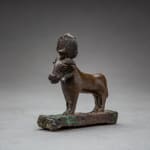Sculpture of the God Amun in the Form of a Ram, 720 BCE - 30 CE
Bronze
1.9 x 6.4 cm
3/4 x 2 1/2 in
3/4 x 2 1/2 in
Z.0038
Further images
This bronze statuette represents a ram gingerly striding forward on integral rectangular base. The ram is modeled with restraint with sculptural emphasis placed on the stylized musculature of its body...
This bronze statuette represents a ram gingerly striding forward on integral rectangular base. The ram is modeled with restraint with sculptural emphasis placed on the stylized musculature of its body rather than an articulation of its fleece. Nevertheless, certain details such as its hooves, tail, horns, and muzzle are more naturally rendered and imbue the figure with a sobriety consistent with its depiction as a manifestation of the state god, Amun. That identification is confirmed by the sun disc fronted by a serpent uraeus, which serves as the ram’s headdress and sole insignia. The cult of the state god Amun rose to prominence during the course of the Egyptian New Kingdom in the late second millennium BCE and continued to maintain its pre-eminent role into the Late Period. So, for example, the Kushite pharaohs of Dynasty XXV linked the Egyptian god Amun of Thebes with their own local deity of Napata worshipped deep in Nubia at Gebel Barkal. Later, in the fourth century BCE, Alexander the Great, in an effort to promote his divine claim, often chose to be depicted with the ram’s horns of Amun as his personal emblem. Our ram can, therefore, be dated to this late resurgence of the cult of Amun. And while, admittedly, there are few known parallels for our particular depiction, its style is consistent with that known for the depiction of other animals, such as the mongoose.
Literature
V1





